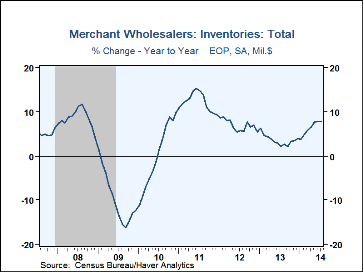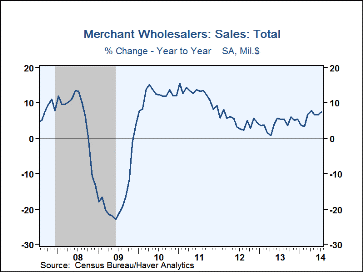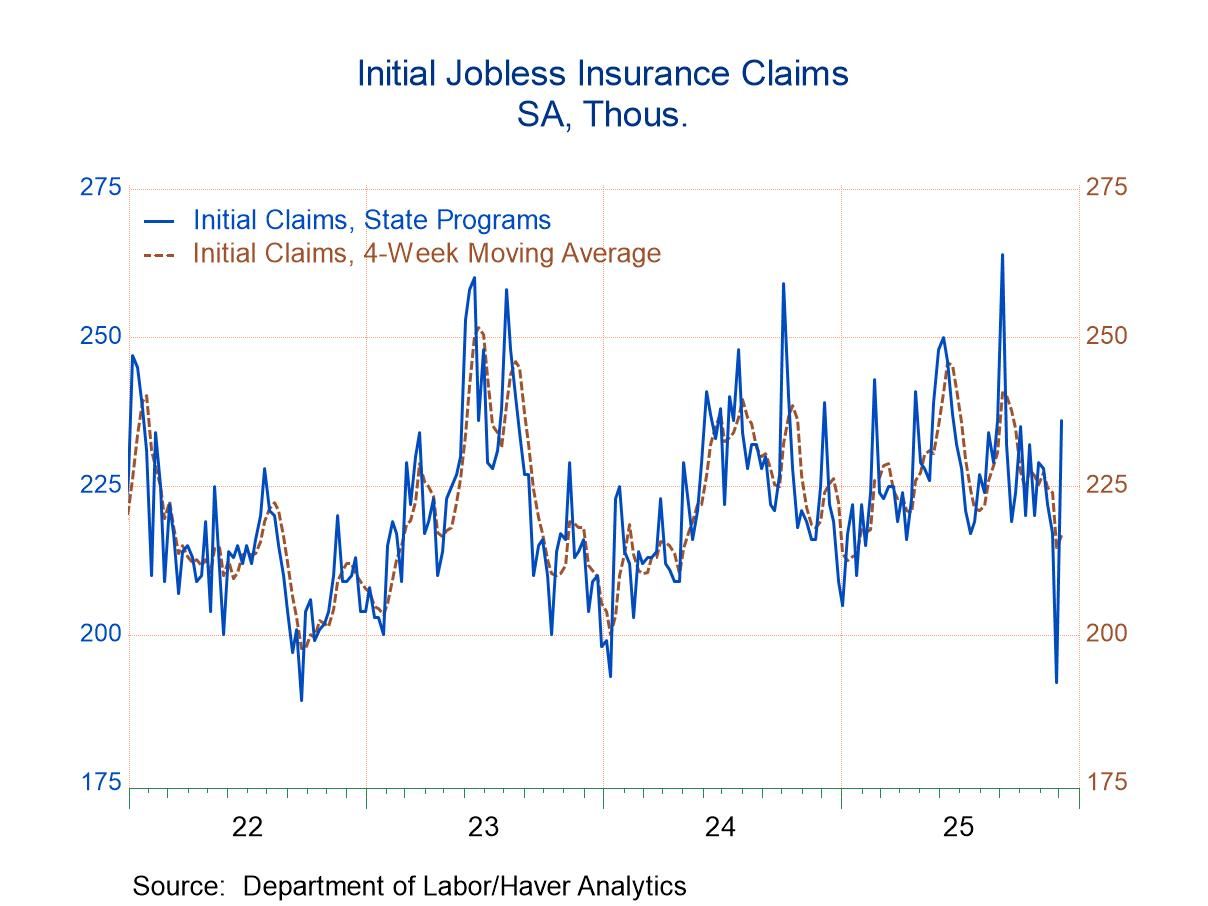 Global| Sep 10 2014
Global| Sep 10 2014U.S. Wholesale Inventories Inch Higher
by:Tom Moeller
|in:Economy in Brief
Summary
Inventories at the wholesale level edged 0.1% higher during July following a 0.2% June increase, revised from 0.3%. Inventories of durable goods increased 0.3% (8.4% y/y). Hardware inventories gained 1.8% (7.6% y/y while motor vehicle [...]
 Inventories at the wholesale level edged 0.1% higher during July
following a 0.2% June increase, revised from 0.3%. Inventories of
durable goods increased 0.3% (8.4% y/y). Hardware inventories gained 1.8%
(7.6% y/y while motor vehicle inventories increased 1.0% (10.9% y/y).
Machinery inventories were up 0.5% (11.4% y/y). To the downside, furniture
inventories slipped 0.2 (+5.6 y/y) and professional equipment inventories
fell 0.8% (+6.4% y/y). In the nondurables sector, inventories were
unchanged (+7.0% y/y). An 8.2% shortfall (-3.4% y/y) in farm product
inventories was accompanied by a 3.0% decline (-6.8% y/y) in petroleum
inventories. Chemical inventories dropped 1.2% (+4.0% y/y) and paper
products inventories fell 0.7% (+2.5% y/y). These declines were offset by
a 3.2% increase (24.2% y/y) in drugs and a 1.9% rise (10.0% y/y) in
apparel. Grocery product inventories rose 1.3% (3.9% y/y).
Inventories at the wholesale level edged 0.1% higher during July
following a 0.2% June increase, revised from 0.3%. Inventories of
durable goods increased 0.3% (8.4% y/y). Hardware inventories gained 1.8%
(7.6% y/y while motor vehicle inventories increased 1.0% (10.9% y/y).
Machinery inventories were up 0.5% (11.4% y/y). To the downside, furniture
inventories slipped 0.2 (+5.6 y/y) and professional equipment inventories
fell 0.8% (+6.4% y/y). In the nondurables sector, inventories were
unchanged (+7.0% y/y). An 8.2% shortfall (-3.4% y/y) in farm product
inventories was accompanied by a 3.0% decline (-6.8% y/y) in petroleum
inventories. Chemical inventories dropped 1.2% (+4.0% y/y) and paper
products inventories fell 0.7% (+2.5% y/y). These declines were offset by
a 3.2% increase (24.2% y/y) in drugs and a 1.9% rise (10.0% y/y) in
apparel. Grocery product inventories rose 1.3% (3.9% y/y).
Wholesales sector sales increased 0.7% (7.5% y/y) led by a 1.0% jump (7.2% y/y) in nondurable goods. A 2.9% gain (9.5% y/y) in groceries paced the increase followed by a 2.6% rise (8.9% y/y) in petroleum. Paper sales rose 1.9% (10.4% y/y) but apparel sales declined 0.6% (+7.3% y/y). Chemical sales also were off 0.3% (+6.3% y/y). To the upside, sales of durable goods edged 0.4% higher (8.0% y/y) led by a 4.5% jump (19.3% y/y in metals. Construction product sales improved 0.7% (7.1% y/y) and sales of furniture gained 0.6% (0.5% y/y). Working the other way, automotive sales slipped 0.2% (9.3% y/y) and commercial equipment sales were off 0.6% (+6.3% y/y).
The inventory-to-sales ratio fell to 1.16, the lowest level since December. The decline was led by a lower nondurables ratio which fell to 0.82, paced by a lessened ratio in paper and sharply lower ratios for groceries & farm products. In the durable goods sector, the I/S ratio held steady at 1.57 as declines in computer equipment and metals were offset by increases in hardware and electrical equipment.
The wholesale trade figures are available in Haver's USECON database.
Assessing Expectations of Monetary Policy from the Federal Reserve Bank of San Francisco is available here.
| Wholesale Sector - NAICS Classification (%) | Jul | Jun | May | Y/Y | 2013 | 2012 | 2011 |
|---|---|---|---|---|---|---|---|
| Inventories | 0.1 | 0.2 | 0.3 | 7.9 | 4.0 | 5.5 | 9.4 |
| Sales | 0.7 | 0.4 | 0.7 | 7.5 | 4.2 | 4.8 | 12.4 |
| I/S Ratio | 1.16 | 1.17 | 1.17 | 1.16 (July'13) | 1.17 | 1.18 | 1.15 |
Tom Moeller
AuthorMore in Author Profile »Prior to joining Haver Analytics in 2000, Mr. Moeller worked as the Economist at Chancellor Capital Management from 1985 to 1999. There, he developed comprehensive economic forecasts and interpreted economic data for equity and fixed income portfolio managers. Also at Chancellor, Mr. Moeller worked as an equity analyst and was responsible for researching and rating companies in the economically sensitive automobile and housing industries for investment in Chancellor’s equity portfolio. Prior to joining Chancellor, Mr. Moeller was an Economist at Citibank from 1979 to 1984. He also analyzed pricing behavior in the metals industry for the Council on Wage and Price Stability in Washington, D.C. In 1999, Mr. Moeller received the award for most accurate forecast from the Forecasters' Club of New York. From 1990 to 1992 he was President of the New York Association for Business Economists. Mr. Moeller earned an M.B.A. in Finance from Fordham University, where he graduated in 1987. He holds a Bachelor of Arts in Economics from George Washington University.








